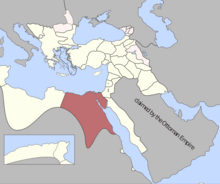Ibrahim Bey
Ibrāhīm Bey Muḥammad (* around 1735 in Georgia or Cherkessia ; † 1816 in Dongola , Sudan ), also called Ibrahim Bey the Great ("al-Kabir"), was an emir of the Mamluks and, together with Murad Bey, regent of Egypt .
Muhammadija
There are different doctrines about Ibrahim's origin. While some Georgian historians claim that he was born to Christian parents in Martkopi, southeast Georgia (in the Gardabani region, which is predominantly inhabited by Muslim Azeris ) and even assign him the Christian name Abram Sinjikashvili , other contemporaries, chroniclers and historians state that he was in the Northern Caucasian settlement area of the Circassians (between the Kuban and the Caucasus ) or even Circassians themselves.
Like his peer Murad Bey (also of Georgian or Circassian origin), Ibrahim was also sold as a slave in Egypt to the Mamluk emir Muhammad Bey Abu Dahab (also of Circassian origin) . He soon released him, gave him his sister as a wife and promoted his ascent. Instigated by the Ottoman-Turkish Sublime Porte , Abu Dahab overthrew his master Ali Bey , who had made Egypt de facto independent from the Porte and supported anti-Ottoman uprisings in Syria. When Abu Dahab himself moved to Syria to fight these uprisings, he left Ibrahim Bey as his deputy in Cairo, but took Murad Bey with him. After Abu Dahab died of the plague in Akko in 1775, his troops had initially chosen Murad Bey as his successor. Aside from a brief rivalry, Ibrahim and Murad agreed to share power.
Under Murad and Ibrahim's joint leadership, the Muhammadija faction (or Abu Dahab faction , the former Mamluks Muhammad Bey Abu Dahab) finally opposed the Ottoman-backed one, despite two necessary retreats to Upper Egypt (1777–1778 and 1786–1791) Allawija faction (Ali Bey faction) under Ismail Bey . They were finally recognized as governors in 1792 by the impotent Sublime Porte.
Duumvirate with Murad Bey
Murad became Amir al-Hajj (commander of the pilgrim caravan) and military governor, Ibrahim Sheikh al-Balad and civil governor. Apart from a brief period (1784–1785) when Murad ousted Ibrahim from Cairo, they ruled together as the Duumvirate . While Murad Bey operated the military rearmament of Egypt, he largely left the business of government to Ibrahim Bey, who, however, always coordinated with him. They divided the tariffs of the country among themselves, Murad received the Nile tariffs, Ibrahim those from the trade with the Hejaz. Mostly Murad Bey ruled over the western bank of the Nile, Ibrahim Bey over the eastern bank. Ibrahim usually chose his villa in the Dāwūdīja district of Cairo as his residence.
Fight against the French and Albanians
The Egyptian expedition of the French ended the Duumvirate in 1798. In contrast to Murad Bey, who withdrew to Upper Egypt via al-Fayyūm and from there waged a guerrilla war against the French before he made up with them in 1800 and submitted to them, Ibrahim Bey made way via Bilbeis and al-Arish to Gaza and Syria and allied with the Ottomans.
After the withdrawal of the French, Ibrahim Bey returned to Cairo in 1801 at the side of Ottoman-Turkish troops and played together with the Mamluk emir Osman Bardīsī (1758-1806) and Murad's successor Alfi Bey (1751-1807) in what followed until 1804 Power struggles between Mamluks, Turkish janissaries, Ottoman governors and Ottoman-Albanian troops initially played a role again as the supreme Mamluk emir and Sheikh al-Balad. When Muhammad Ali Pasha , the commander of the Albanian troops, prevailed and attacked the Mamluks, Ibrahim and Bardīsī had to leave the city in March 1804, but Ibrahim stayed in Giza until 1805 before he fled to Upper Egypt. With a few hundred others he escaped the massacre committed by Muhammad Ali of the Mamluks in the Cairo citadel in 1811. However, his son Marzuk died in Cairo.
The remaining Mamluks fled via Upper Egypt to Nubia in 1812, where they settled in Dongola . In Dongola, the now 80-year-old Ibrahim Bey finally died of malaria, the remaining Mamluks were increasingly decimated in battles with the Sheygya (Sudan Arabs). The last bastion of the aging Mamluks in Dongola later served Muhammad Ali as a pretext to allow Sennar and Sudan to be conquered by his son Ibrahim Pascha .
literature
- ʿAbdarraḥmān al-Ǧabartī, Arnold Hottinger (translator): Bonaparte in Egypt - From the chronicles of ʿAbdarraḥmān al-Ǧabartī , pages 333–338 and 370–374. Piper, Munich 1989
- Robin Leonard Bidwell : Dictionary of Modern Arab History , pages 205 and 286f. London / New York 1998
- Bethwell A. Ogot: General History of Africa , Volume 5 (Africa from the Sixteenth to the Eighteenth Century), 166–166. Paris / Berkeley 1992
Individual evidence
- ↑ a b Alexander Mikaberidze: The Georgian Mameluks in Egypt
- ↑ a b Marie-Nicolas Bouillet , Alexis Chassang (ed.): Dictionnaire universel d'histoire et de géographie , page 910 . Hachette, Paris 1869
- ^ The news of his death reached Cairo in March 1816, but some other sources give the year 1817 as the year of his death
- ↑ P. Kahle: Encyclopaedia of Islam , article on Ibrāhīm Bey . Brill online 2014
- ^ Andrew James McGregor: A Military History of Modern Egypt - from the Ottomon Conquest to the Ramadan War , 68. Westport 2006
| personal data | |
|---|---|
| SURNAME | Ibrahim Bey |
| ALTERNATIVE NAMES | Ibrahim Beg; Ibrahim Bek; Ibrahim Bei; Ibrahim Bey al-Kabir; Ibrahim Bek al-Kabir |
| BRIEF DESCRIPTION | Bey of the Mamluks in Egypt |
| DATE OF BIRTH | 1735 |
| PLACE OF BIRTH | Georgia |
| DATE OF DEATH | 1816 |
| Place of death | Dongola , Sudan |


